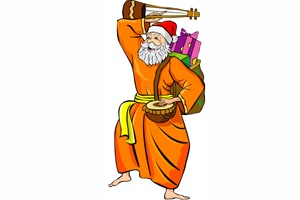
Christmas puja is what the Santa Claus cap is for,explain beggars-turned-salespersons at traffic jams. Kolkata footpaths are piled high with plum cakes ranging from Rs 20 to
Rs 100. Indian Christians decorate their homes with earthen diyas to welcome the birth of Christ just like Hindus welcome the return of Ram,Sita and Lakshman from their 14-year vanabas(exile) on Diwali.
The way McDonalds,KFC and Maggi noddles are becoming the Indian national standard,Christmas drives commercial avenues just like Dussehra,Durga puja,Ramzan,Onam and Bihu do. But its the top money-spinner as its celebrated worldwide. In Europe alone,total Christmas sales are expected to rise slightly to 313 billion euros,equivalent to 16 per cent of annual retail sales. Of this 10.3 per cent will be online sales.
Pre-Christmas festivity is very strongly visible nowadays. From across US,Canada,UK,Bangladesh,East Timor,Germany,Jordan,France,Pakistan and different parts of India,Loreto Shillong girls came for a reunion in the manicured lawns of a colonial South Delhi home. When I walked into that event surrounded with choir music on a chilly early December evening,I wasnt sure if Id arrived somewhere in England. The fervour of the Loreto alumni singing their traditional jingle,To East and West of that Fair Isle (meaning Ireland),Where the first Loreto stands,Loretos banner now doth fly in many distant lands…Loretos name each girl reveres,And holds it ever blest… displayed the tremendous strength of their old-school tie.
Suddenly a beautiful,trance-inducing voice singed the cold air. A Baul singer,those wandering spiritual Sufi musicians of Bengal,strumming his ektara(stringed instrument) belted out in Bengali dialect,Din duniyar malik khoda,Tomar dil ki doya hoi na (God,you are the owner of the world of the poor,Have you no compassion in your heart)? His Loreto Shillong wife was accompanying him with small Bengali cymbals called kortal. I knew her from Paris where they are part of the World Music scene. Here they were,disrupting the Irish Catholic atmosphere with mystical,nomadic culture thats more than five centuries old.
Then without much ado,the Loreto women enthusiastically joined in for Jingle Bells.This made me imagine Indias Yuletide spirit some 70 years ago. After some time,the alumni started to sing and dance with their husbands to European pop and disco numbers from the 1970s. That was the time I had left my poverty-ridden life in India. I now saw how familiarly the Loreto girls were enjoying what I saw only on arrival in France. This alumni party proved to me their versatility in being comfortable celebrating the Catholic origin of Ireland,the rollicking dance steps that Abba induced,and switch to paying rapt attention to minstrel Baul music.
A certain higher class,and of course all Christians,celebrated Christmas with our colonial masters. Today Christians decorate their homes with banana or mango trees and fill churches with red poinsettia flowers. With economic development,Christmas now puts everyone in a festive mood,irrespective of religion.
I made another discovery when one of my American friends in Bangalore invited us for a Christmas party on December 11. There were several Indians with children,adeptly singing Christmas carols on karaoke with American accents. My pre-Europe Kolkata experience was Burra Din on 25th December,but in Europe I learnt Christmas means 24th December night. Celebration with friends is on December 31. But easy-going Americans have stretched Christmas to a month-long entertainment. Their marketing efficiency makes Christmas typically account for up to 25 per cent of the retail industrys annual sales.
How did Christmas carols originate? According to Clement Miles,author of Christmas Customs and Traditions,Christmas hymns started in 4th Century Rome. The 13th Century saw Christmas songs in their native French,German and Italian languages under the influence of Francis of Assisi. The carols we recognise today were originally communal songs sung during celebrations such as harvest tide. It is recorded that ancient European pagans celebrated the midwinter and other festivals long before Christianity ever existed. Babylonians celebrated the feast of the Son of Isis with eating,drinking,gift giving. The church under Pope Julius I declared that Christs birth would be celebrated on December 25 in 350 AD which fructified in 378 AD. Scandinavian countries celebrated Yule honouring Thor. In Germania,midwinter night celebrations meant 12 wild nights of eating and drinking. On December 25,the Romans celebrated their god Sol Invictus. The earliest known reference to December 25 as the nativity date is found in Chronography of 354,an illuminated manuscript compiled in Rome.
Several cultures are known to have December 25 as their gods birth date,such as Mithras of the Persians; Osiris,god of the dead and underworld in Egypt; and in Greece,Adonis and Hercules. Christmas is a very big festival in all GCC countries.
Returning from Delhi on December 23,I reached the airport two hours ahead and was subjected to the grating Jingle Bells sung in continuous repetition. This is another innovative American characteristic. They have created a standard song and internationalised it as entertainment.The expression Happy Holidays in place of Merry Christmas originated in America as many controversies surround the inception of Christmas. But the spreading power of Christianity has reached modern cellphone-using youngsters who are forwarding up to 500 SMSes accompanied by Jingle Bells.
Shombit Sengupta is an international creative business strategy consultant to top management. Reach him at http://www.shiningconsulting.com